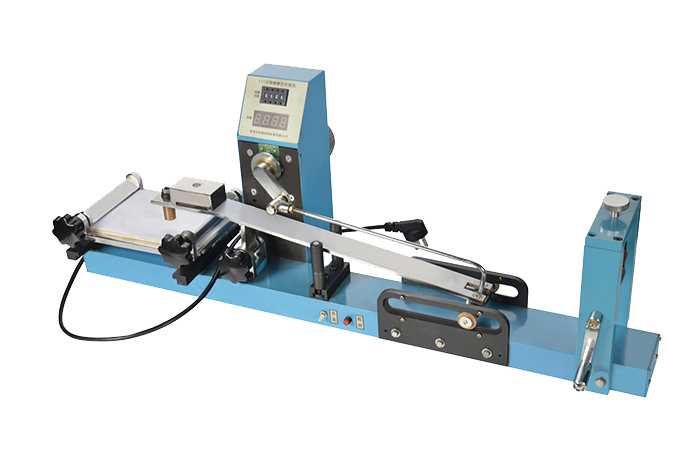Popular science knowledge of textile color fastness tester
Textile color fastness tester mainly tests including water resistance, acid and perspiration resistance, alkali perspiration resistance, dry rubbing resistance, saliva resistance, etc. The test volume is usually large, and the color fastness test needs to take samples of each hue. Multi-color fabrics often require multiple samples. Based on a large amount of work experience, this article analyzes and recommends rapid color fastness testing and precautions in the process, and provides a technical reference for the laboratory to improve the efficiency of color fastness testing.
1.Color fastness to rubbing
The color fastness to rubbing in GB/T 3920—2008 is to assess the degree of staining of textiles after rubbing. In actual operation, after rubbing of knitted products, the rubbing cloth may produce halo phenomenon (see Figure 4). The edges of the cloth circles are stained darker, and the middle part is stained lightly. Different parts of the rubbing cloth will be graded differently. The standard stipulates that the sample size is not less than 50mm×140mm. Because knitted products are more elastic, it is easy to curl on both sides. In order to eliminate the halo phenomenon, the test results can represent the true rubbing fastness of the sample and reduce the number of repeated tests. For such products, ensure that the sample is completely straightened in the vertical direction. The flat part after straightening is not less than 3cm, so that the sample is rubbed and not slipped in a completely flat state to obtain satisfactory test results. If the halo phenomenon cannot be completely eliminated, the rating will be based on the number of the center of the circle. If the edge is darker, the rating will be lowered appropriately, but the reduction will not exceed half a level.

2.Color fastness to heat pressing
GB/T 6152-1997 "Textile color fastness test color fastness to heat-resistant pressing" stipulates that the pressing temperature is determined according to the type of fiber and the structure of the fabric or clothing. For example, the recommended temperature should be used for blended products. It is compatible with the most heat-labile fibers, usually using (110±2) ℃, (150±2) ℃, (200±2) ℃ 3 kinds of temperature, but it does not provide the corresponding detection temperature of the specific product. Some product standards will specify specific temperature, but some product standards do not. In actual operation, the choice of temperature will be confused, and it is even necessary to conduct multiple tests at different temperatures to determine the best temperature. Therefore, if the test temperature is not specified in the product standard, it is recommended to refer to GB/T 24280-2009 "Guidelines for the Selection of Maintenance Symbols on Textile Maintenance Labels" Appendix C: Ironing temperature and AATCC 133-2013 in the initial test conditions of typical textile fiber products The safe ironing temperature guide in "Color fastness to heat: hot pressing" selects the appropriate temperature for testing according to different fiber types. For fabrics containing multiple fibers, select the lowest temperature test of the constituent fibers. See Table 4 for specific examples. .
3.Color fastness to soaping
After the color fastness test to soaping is finished, the sample should be cleaned sufficiently to avoid the residual liquid of soap on the sample to make the color of the sample white, or contain residual dyes to aggravate the staining of the lining fabric and affect the test. As a result, re-sampling is required to increase the test time. Therefore, when cleaning, pay attention to whether there is soap or dye residue on the sample and the lining fabric. If it is difficult to completely remove, you can rinse the sample repeatedly in warm water around 40℃ and remove the residue by hand before drying. Dry.
After the sample is completely dried, if there are still white spots on the fabric that affect the evaluation of the discoloration level of the sample, it is caused by soap stain (the calcium and magnesium ions released from the dye and the fatty acid in the soap flakes) during the test. Combination of metal salts). The dried sample can be subjected to acid treatment, that is, "treat it in 100 mL of acetic acid solution (with a concentration of 0.2 g/L) at 30°C for 1 minute, and then rinse it in 30°C, 100 mL of tertiary water for 1 minute." Solve the problem of residual white spots affecting the evaluation of discoloration results, and then grade after drying again, without repeating the test.
If you are interested in textile color fastness tester, please leave us a message!
2021-11-19 13:42
- Related News
FAQs about Garment processing equipment
What is the Vertical Flame Test?
What is a needle flame tester?
What is a Dry Microbial Penetration Tester?
Top 10 Fiber Fineness Testing Instruments
Top 10 Penetration & Permeability Testing Instruments
Top 10 Comfort Testing Instruments
